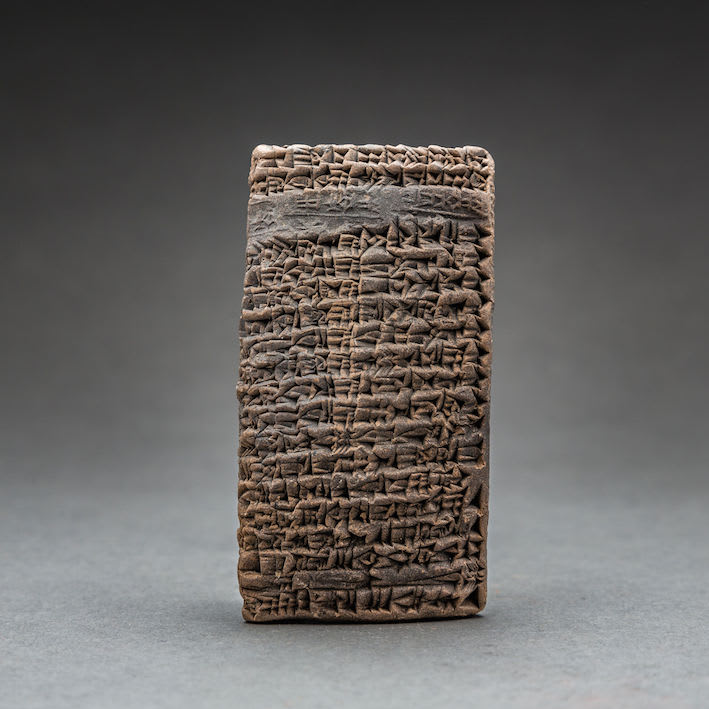Old Babylonian Terracotta Cuneiform Tablet, 1834 BCE - 1831 BCE
Terracotta
9.5 x 5.1 cm
3 3/4 x 2 in
3 3/4 x 2 in
LO.1247
Further images
This tablet has a total of 34 lines of Sumerian cuneiform on obverse and reverse. It is dated to a year of Iter-pisha, king of Isin in southern Mesopotamia c....
This tablet has a total of 34 lines of Sumerian cuneiform on obverse and reverse. It is dated to a year of Iter-pisha, king of Isin in southern Mesopotamia c. 1834-1831 B.C., but the precise year is not known since the year name used cannot be assigned to a particular year of this short reign.
Translation:
4 1/2 : (the area of) a house of reed walls erected (in the ground), with a wooden door in the outer gate, the house of Tab-kar-Enlil, Bur-Enlil, Nur-kabta, Iddin-Sin and Shalurum, his brothers, heirs of Tab-silli-Ninkarrak, adjacent to the house of Kinum and … -Sin:
1/3 of a mina and 4 shekels of silver were weighed out as its full price. Ilum-Tayyar, son of Iddin-Ishtar, purchased it from Tab-kar-Enlil, Bur-Enlil, Nur-Kabta, Iddin-Sin and Shalurum, his brothers.
In the future Tab-kar-Enlil, Bur-Enlil, Nur-Kabta, Iddin-Sin and Shalurum, his brothers, and as many heirs as there may be, may not claim the house. They swore by the king.
In the presence of Didanum and his son Uta-ah Ilam-nada, son of Habil-bel Yawsi-ilum, son of Puzur-Ninkili Adad-bani, and his son Uta-ah Damu-asu, son Puzur-Shamas Humusi, son of Nabi-Enli Bur-Adad, son Zabiy A hum-waqar, son Damu-tali
Month Tebet, year: Iter-pisha, the king, made a copper drum for Shamas
All four edges bear impressions of the seal of: Nur-Kabta, son of Tab-silli-Ninkarrak
The tablet is well written and very well preserved save for one spot of damage on the obverse. A was an area of 12 x 12 cubits.
Description and translation kindly provided by Professor W. G. Lamber
Translation:
4 1/2 : (the area of) a house of reed walls erected (in the ground), with a wooden door in the outer gate, the house of Tab-kar-Enlil, Bur-Enlil, Nur-kabta, Iddin-Sin and Shalurum, his brothers, heirs of Tab-silli-Ninkarrak, adjacent to the house of Kinum and … -Sin:
1/3 of a mina and 4 shekels of silver were weighed out as its full price. Ilum-Tayyar, son of Iddin-Ishtar, purchased it from Tab-kar-Enlil, Bur-Enlil, Nur-Kabta, Iddin-Sin and Shalurum, his brothers.
In the future Tab-kar-Enlil, Bur-Enlil, Nur-Kabta, Iddin-Sin and Shalurum, his brothers, and as many heirs as there may be, may not claim the house. They swore by the king.
In the presence of Didanum and his son Uta-ah Ilam-nada, son of Habil-bel Yawsi-ilum, son of Puzur-Ninkili Adad-bani, and his son Uta-ah Damu-asu, son Puzur-Shamas Humusi, son of Nabi-Enli Bur-Adad, son Zabiy A hum-waqar, son Damu-tali
Month Tebet, year: Iter-pisha, the king, made a copper drum for Shamas
All four edges bear impressions of the seal of: Nur-Kabta, son of Tab-silli-Ninkarrak
The tablet is well written and very well preserved save for one spot of damage on the obverse. A was an area of 12 x 12 cubits.
Description and translation kindly provided by Professor W. G. Lamber









